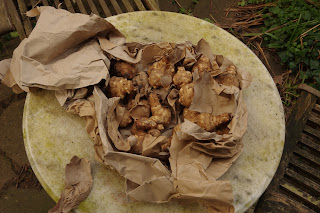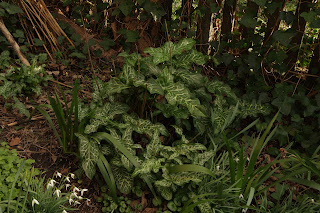I covered this bed on the allotment with cardboard several months ago. It's pretty mushy by now but still working as a permeable membrane to suppress weeds.
It would be fine to let plain brown cardboard disintegrate and mulch into the soil but I'm ready to use this bed so I removed it. Underneath there was a thatch of decaying organic matter which I raked off.
In fact all the weeds and seeds remaining in the soil will make a comeback now they are exposed to sunlight. It would be necessary to cover a bed for at least a year or two to eliminate them. Last year's Borage and Nasturtium self-seeded here so I want them to germinate.
And this is what I planted: knobbly Jerusalem Artichokes. I grew some in the adjacent bed last year. They got very tall, about 9ft high by late September at which point a few flowers appeared. The Borage and Nasturtium made a nice underplanting.
This year I'm trying a variety called 'Stampede' which are said to grow to about 6ft and flower in July. I hope so, the bright yellow flowers of Jerusalem Artichokes are an attractive sight. Botanically speaking they are Helianthus tuberosus, the same genus as Sunflowers.
It's also a good time to dig up this year's harvest. This pile is the crop that resulted from four or five of the twenty or so tubers I planted last time. Each one has generated at least a dozen more!
Jerusalem Artichokes don't store particularly well which doesn't matter; leave them in the ground and dig them up when you need them. Late winter is the best time, they are said to be a touch sweeter after frosts. In spring they will start to sprout new stems; this is a species that multiplies itself prolifically and requires no maintenance. The surplus can be replanted.
I'm not sure which variety I planted before. I bought them at a farmers' market where they were being sold for culinary purposes. As seen above they have a reddish tinge to the skin when the mud is scrubbed off.
At this point I should strike a note of caution. Back in the seventeenth century the botanist John Goodyer had this to say:
"which soever way they be dressed and eaten, they stir and cause a filthy loathsome stinking wind within the body, thereby causing the belly to be pained and tormented".
He's got a point. What's good/bad about Jerusalem Artichokes is they are rich in inulin which is a non-digestible prebiotic fibre. Nonetheless it does great things for your gut microbiome as it passes through. Roasting Artichokes is one option and some people even have them raw in salads which is brave. I reckon the best way to avoid indigestion is to make soup.
I have made a vat comprising olive oil, onions, garlic, dried turmeric, paprika, Artichokes and carrots (half and half), water with vegetable stock, lemon slices and black pepper. Once the veg was cooked I used a blender for a consistency somewhere between watery and creamy. By doing so the fibre will still be present but as small particles rather than chunks. Delicious and very palatable.




























